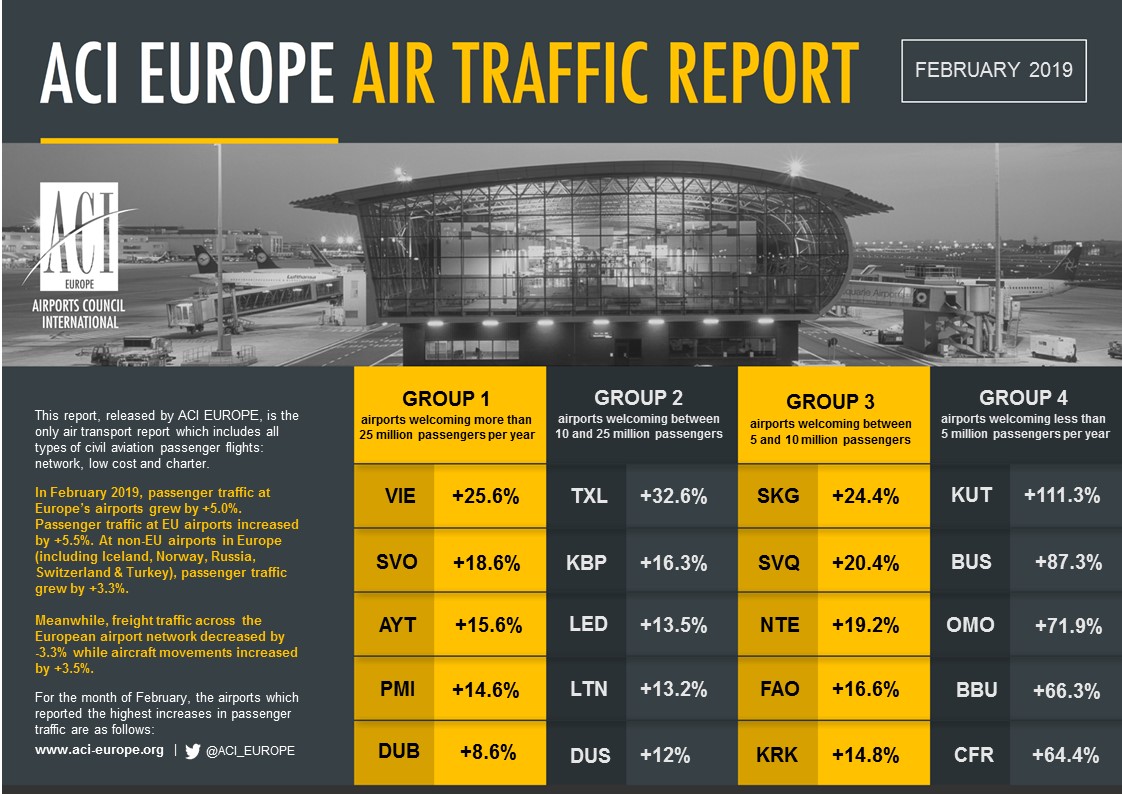February passenger traffic up 5%, but freight traffic keeps decreasing
9 April 2019Brussels - European airport trade association, ACI EUROPE today releases its traffic report for February 2019, during which average passenger traffic in geographical Europe grew by +5% compared with the same month last year – an improvement over the performance registered in January (+4.2%).
Conversely, February marked the 4th consecutive monthly decrease in freight traffic, which further worsened to -3.3%.
Olivier Jankovec, Director General of ACI EUROPE commented “Even though passenger traffic growth has somehow moderated compared to last year, it remains dynamic and keeps defying weakening economic trends as well as significant geopolitical risks – for now. The performance gap with freight traffic is impressive, especially in the EU market. This is not going to last forever. By all odds, passenger traffic growth is set to decelerate in the coming months.”
EU AIRPORTS LEADING PASSENGER GROWTH
TheEU market led the passenger growth dynamic, with airports throughout the bloc posting an average increase of +5.5%. Double-digit growth was achieved by airports in Austria, Croatia, Estonia, Greece, Luxembourg, Poland and Slovakia – while airports in Cyprus, France, Ireland, Italy, Spain and most of the Eastern part of the bloc also grew above the EU average.
Meanwhile airports in Denmark, Finland, Malta, the Netherlands and the UK generally grew below the EU average, while those in Belgium saw their gains wiped out by an ATC strike on 13 February that completely shut down the country’s airspace. Airports in Sweden were the only ones losing passenger traffic (-3.4%) - a trend which followed the introduction of an aviation tax last year and also reflects changing attitudes towards air transport in the country.
The following larger & capital airports in the EU registered the best performances: Berlin-Tegel (+32.6%), Vienna (+25.6%), Palma de Mallorca (+14.6%), Tallinn (+13.9%), London-Luton (+13.2%), Dusseldorf (+12%), Athens (+11.4%), Bratislava (+11.4%), Edinburgh (+11%), Milan-Malpensa (+10.7%), Bucharest (+10.4%), Warsaw-Chopin (+10.2%), Dublin (+8.6%) and London-Stansted (+8.2%).
Airports in the non-EU market saw passenger traffic increasing by just +3.3%, mainly as a result of decreasing traffic volumes in Turkey (-2.1%) and Iceland
(-6.5%). However, airports in Albania, Belarus, Georgia, Macedonia and Ukraine registered double digit-growth, while growth was also very dynamic at Russian airports.
Accordingly, the best results amongst non-EU larger & capital airports came from Moscow-Sheremetyevo (+18.6%), Kiev (+16.3%), Minsk (+16.2%), Antalya (+15.6%), Tirana (+14%), Saint Petersburg (+13.5%), Tbilisi (+13.1%) and Pristina (+11.9%).
The Majors (top 5 European airports) registered passenger growth of +2.8%
- an improvement compared to January (+1.3%) mainly driven by the performance of Paris-CDG (+7.1%) and Frankfurt (+4.3%) as well as lower traffic losses at Istanbul-Ataturk (-0.8% compared to –2.6% in January). Capacity constraints kept limiting growth at Amsterdam-Schiphol (+2.0%) and London-Heathrow (+1.6%).
FREIGHT NEGATIVE BOTH IN THE EU & NON-EU MARKETS
While freight traffic at EU airports kept falling with a decrease of -3.7% in February, it also turned negative at non-EU ones at -1.2%. Amongst the top 10 European airports for freight traffic only 3 posted gains: Liège (+9.3%), Madrid (+6.8%) and Istanbul-Ataturk (+2.3%).
Aircraft movements were up +3.5% - increasing by +3.9% in the EU market and by +2.1% in the non-EU bloc.
During the month of February, airports welcoming more than 25 million passengers per year (Group 1), airports welcoming between 10 and 25 million passengers (Group 2), airports welcoming between 5 and 10 million passengers (Group 3) and airports welcoming less than 5 million passengers per year (Group 4) reported an average adjustment +4.6%, +6.4%, +4.6% and +3.7%.
The airports that reported the highest increases in passenger traffic during
February 2019 (compared with February 2018) are as follows:
GROUP 1: Vienna (+25.6%), Moscow SVO (+18.6%), Antalya (+15.6%) Palma de Mallorca (+14.6%) and Dublin (+8.6%)
GROUP 2: Berlin TXL (+32.6%), Kiev (+16.3%), St Petersburg (+13.5%),
London LTN (+13.2%) and Dusseldorf (+12%)
GROUP 3: Thessaloniki (+24.4%), Seville (+20.4%), Nantes (+19.2%),
Faro (+16.6%) and Krakow (+14.8%)
GROUP 4: Kutaisi (+111.3%), Batumi (+87.3%), Mostar (+71.9%),
Bucharest BBU (+66.3%) and Caen (+64.4%)
The 'ACI EUROPE Airport Traffic Report – February 2019 includes 248' airports in total representing more than 88% of European air passenger traffic.
ACI EUROPE Airport Traffic Reports are unique in that they are the only ones to include all types of airline passenger flights to, from and within Europe: full service, low cost, charter and others.


